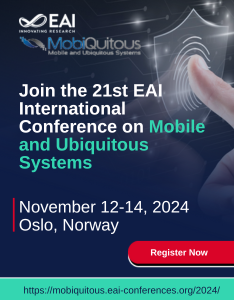
Research Article
WISEglass: Smart eyeglasses recognising context
@ARTICLE{10.4108/eai.28-9-2015.2261470, author={Florian Wahl and Martin Freund and Oliver Amft}, title={WISEglass: Smart eyeglasses recognising context}, journal={EAI Endorsed Transactions on Pervasive Health and Technology}, volume={2}, number={5}, publisher={ACM}, journal_a={PHAT}, year={2015}, month={12}, keywords={context inference, mobile sensing, smart glasses, activity recognition, eyewear}, doi={10.4108/eai.28-9-2015.2261470} }- Florian Wahl
Martin Freund
Oliver Amft
Year: 2015
WISEglass: Smart eyeglasses recognising context
PHAT
EAI
DOI: 10.4108/eai.28-9-2015.2261470
Abstract
We investigated how regular eyeglasses could be extended with multi-modal sensing and processing functions to support context-awareness applications. Our aim was to leverage eyeglasses as a platform for acquiring and processing context information according to the wearer’s needs. The WISEglass architecture consists of inertial motion, environmental light, and pulse sensors, processing and wireless data transmission functionality, besides a rechargeable battery. We implemented prototypes of WISEglass and evaluated them in three application scenarios: daily activity recognition, screen-use detection, and heart rate estimation. We conducted a daily activity study with nine participants, each wearing WISEglass and recording for one day. When evaluating daily activity recognition, we obtained 77 % average accuracy for continuous recognition using Gaussian Mixture Models and classifier reject to ignore null class data. Using the light sensor for detecting screen-use, yielded 80 % accuracy. Against a chest-worn ECG reference, our heart rate estimation showed an difference below 10 beats for stationary activities across the full recording day. We concluded that smart eyeglasses provide information from a single measurement spot that is relevant in various context recognition applications.
Copyright © 2015 F.Wahl et al., licensed to EAI. This is an open access article distributed under the terms of the Creative Commons Attribution licence (http://creativecommons.org/licenses/by/3.0/), which permits unlimited use, distribution and reproduction in any medium so long as the original work is properly cited.


